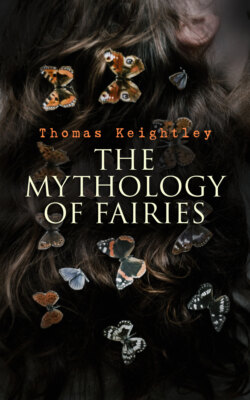Читать книгу The Mythology of Fairies - Thomas Keightley - Страница 28
На сайте Литреса книга снята с продажи.
Hans Puntleder.
ОглавлениеThere are three hills on the lands of Bubbelgaard in Funen, which are to this day called the Dance-hills, from the following occurrence. A lad named Hans was at service in Bubbelgaard, and as he was coming one evening past the hills, he saw one of them raised on red pillars, and great dancing and much merriment underneath. He was so enchanted with the beauty and magnificence of what he saw, that he could not restrain his curiosity, but was in a strange and wonderful manner attracted nearer and nearer, till at last the fairest of all the fair maidens that were there came up to him and gave him a kiss. From that moment he lost all command of himself, and became so violent, that he used to tear to pieces all the clothes that were put on him, so that at last they were obliged to make him a dress of sole-leather, which he could not pull off him; and ever after he went by the name of Hans Puntleder, i.e. Sole-leather.144
* * * * *
According to Danish tradition, the Elle-kings, under the denomination of Promontory-kings, (Klintekonger), keep watch and ward over the country. Whenever war, or any other misfortune, threatens to come on the land, there may be seen, on the promontory, complete armies, drawn up in array to defend the country.
One of these kings resides at Möen, on the spot which still bears the name of King's-hill (Kongsbjerg). His queen is the most beautiful of beings, and she dwells at the Queen's Chair (Dronningstolen). This king is a great friend of the king of Stevns, and they are both at enmity with Grap, the promontory-king of Rügen, who must keep at a distance, and look out over the sea to watch their approach.
Another tradition, however, says, that there is but one king, who rules over the headlands of Möen, Stevns, and Rügen. He has a magnificent chariot, which is drawn by four black horses. In this he drives over the sea, from one promontory to another. At such times the sea grows black, and is in great commotion, and the loud snorting and neighing of his horses may be distinctly heard.145
It was once believed that no mortal monarch dare come to Stevns; for the Elle-king would not permit him to cross the stream that bounds it. But Christian IV. passed it without opposition, and since his time several Danish monarchs have been there.
At Skjelskör, in Zealand, reigns another of these jealous promontorial sovereigns, named king Tolv (Twelve). He will not suffer a mortal prince to pass the bridge of Kjelskör. Wo, too, betide the watchman who should venture to cry twelve o'clock in the village, he might chance to find himself transported to the village of Borre or to the Windmills.
Old people that have eyes for such things, declare they frequently see Kong Tolv rolling himself on the grass in the sunshine. On New-year's night he takes from one smith's forge or another nine new shoes for his horses; they must be always left ready for him, and with them the necessary complement of nails.
The Elle-king of Bornholm146 lets himself be occasionally heard with fife and drum, especially when war is at hand; he may then be seen in the fields with his soldiers. This king will not suffer an earthly monarch to pass more than three nights on his isle.
In the popular creed there is some strange connexion between the Elves and the trees. They not only frequent them, but they make an interchange of form with them. In the church-yard of Store Heddinge,147 in Zealand, there are the remains of an oak wood. These, say the common people, are the Elle-king's soldiers; by day they are trees, by night valiant warriors. In the wood of Rugaard, in the same island, is a tree which by night becomes a whole Elle-people, and goes about all alive. It has no leaves upon it, yet it would be very unsafe to go to break or fell it, for the underground-people frequently hold their meetings under its branches. There is, in another place, an elder-tree growing in a farm-yard, which frequently takes a walk in the twilight about the yard, and peeps in through the window at the children when they are alone.
It was, perhaps, these elder-trees that gave origin to the notion. In Danish Hyld or Hyl—a word not far removed from Elle—is Elder, and the peasantry believe that in or under the elder-tree dwells a being called Hyldemoer (Elder-mother), or Hyldequinde (Elder-woman), with her ministrant spirits.148 A Danish peasant, if he wanted to take any part of an elder-tree, used previously to say, three times—"O, Hyldemoer, Hyldemoer! let me take some of thy elder, and I will let thee take something of mine in return." If this was omitted he would be severely punished. They tell of a man who cut down an elder-tree, but he soon after died suddenly. It is, moreover, not prudent to have any furniture made of elder-wood. A child was once put to lie in a cradle made of this wood, but Hyldemoer came and pulled it by the legs, and gave it no rest till it was put to sleep elsewhere. Old David Monrad relates, that a shepherd, one night, heard his three children crying, and when he inquired the cause, they said some one had been sucking them. Their breasts were found to be swelled, and they were removed to another room, where they were quiet. The reason is said to have been that that room was floored with elder.
The linden or lime tree is the favourite haunt of the Elves and cognate beings; and it is not safe to be near it after sunset.149
